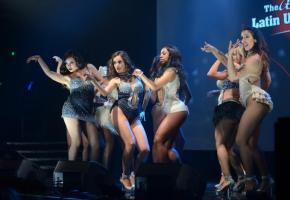The topless young men, performing the most unimaginable acrobatics as they enter the roda one by one, their muscular, naked torsos shining under the stage lights, may not meet the approval of Waldeloir Rego. In 1968 the famous Brazilian anthropologist’s PhD thesis Capoeira Angola; um ensaio socio-etnográfico, (probably the most sought-after publication within the international Capoeira community) voiced concerns over the transformation that Capoeira shows were undergoing within the tourist industry in Brazil. Rego believed that Capoeira was losing its authenticity because of the need to captivate a paying audience through increasingly novel moves. What Rego would have thought of many of today’s Contemporary Capoeira shows, which have gone way beyond adding a bit of samba de roda in the midst, we can only hazard a guess.
Of course, not all 21st century Capoeira shows are like this. We must also remember that Capoeira shows are just that – they are shows, snippets of entertainment that reveal part, but not the whole, of Capoeira itself. However, what is certain is that Capoeira – as a performance and as a whole – like many other forms of popular culture has become locked into the debate of tradition versus progress, authenticity versus evolution. Has Contemporary Capoeira, aesthetically speaking, with its array of acrobatics, abandoned its roots completely? Or, does it simply offer a more modern representation of a centuries-old Brazilian tradition?
Defining the impossible
Before trying to establish where Contemporary Capoeira and its shows fit along the line of authenticity we must first look at the bigger picture: what is Capoeira? Different capoeiristas appear to interpret the term ‘Capoeira’ in different ways. For some, Capoeira is a competitive sport, for others it is a mixture between dance and martial art, while others again see it as an amalgamation of all these things and much more.
That there is no one single definition of Capoeira that suits all is not surprising; after all, there are different styles of Capoeira – Angola, Regional and Contemporary. However, the defining of Capoeira in a few words seems even more problematic than the differences in style. Many have even embraced this ambiguity. Mestre Pastinha – the renowned Capoeira Angola master – referred to Capoeira as “tudo que a boca come” (“everything one can eat”), clearly alluding to the indefinable nature of this Brazilian tradition. Contemporary Capoeira master Mestre Chitãozinho, in his book ABC da Capoeira (2006), takes a similar stance, insisting that “se ousássemos em poucas palavras explicar o que é a capoeira, louco seria aquele que abraçasse a tese como verdadeira” (“if we dared to explain in just a few words what capoeira is, only a fool would embrace this explanation as true”).
According to Luiz Renato Vieira, political sociologist and author of O jogo da capoeira: corpo e cultura popular no Brasil (1995), many capoeiristas choose not to define Capoeira at all, they prefer to portray Capoeira as something that “envolve todas essas dimensões da cultura” (“involves all these cultural dimensions”). Despite its ambiguity, Capoeira can be loosely defined according to its particular styles. Capoeira Angola and Capoeira Regional are, nowadays, generally viewed as more traditional forms: Capoeira Angola is seen as more dance-like and heavily steeped in mandiga (a Capoeira term meaning ‘malicious’) and malandragem (trickery), Capoeira Regional is viewed as more of a fight, with clean, fast and powerful moves, although both incorporate all of these elements, at differing levels, within their game.
Angola y Regional – the traditional, the authentic...the only?
Capoeiristas from both Capoeira Angola and Capoeira Regional have been known to participate in shows – in 1936 Mestre Bimba, the creator of Regional, was even asked to perform before the State Governor of Bahia and his guests. Both styles, however, reject the incorporation of acrobatics into the game of Capoeira. Mestre João Grande, student of the great Mestre Pastinha of Capoeira Angola, once said in an interview that “Capoeira Angola não tem esses pulos malucos” (Capoeira Angola doesn’t have these crazy jumps”). In another interview Capoeira Regional master Mestre Nenel, son of Mestre Bimba, insisted that he did not dislike the use of acrobatics in Capoeira, and even found them aesthetically pleasing. What bothered him was the mistaken association between these acrobatics and his father’s name. Mestre Nenel set the record straight and maintained that his father, creator of the Capoeira Regional style, “era contra esse negócio de pular” (“was against this practice of flipping”).
It is with the dawn of Contemporary Capoeira, whose prospective presence could already be felt by the end of the 1960s, and the emergence of capoeiristas like Mestre Suassuna and Mestre Camisa, that acrobatics became an integral part of Capoeira and the Capoeira show. In an interview with Tania Voss, Mestre Suassuna admitted that he only truly started to enjoy Capoeira when he began to incorporate jumps, flips, and other interesting movements into the game. In fact, he even confessed that at first he had seen Capoeira as a “coisa para velho de 80 anos” (“thing for 80 year-olds”). It seems, therefore, that acrobatics came to form an important part of Capoeira for a younger generation that felt, in part, that this Brazilian tradition needed something new; that it needed something contemporary.
To Flip or not to Flip?
Contemporary Capoeira has embraced acrobatics, but does this mean losing its authenticity? There is a time and place for acrobatics in the Capoeira game, Mestre Chitãozinho warns, no capoeirista should simply “ficar soltando” (“keep doing flips”) as displayed in Mestre Suassuna’s DVD Capoeirando 2004. With the tropical beaches of Ilheús as a backdrop, one by one, the toned topless men enter the roda, throwing themselves up into the air, spinning, back-flipping, twisting and turning their bodies in the most extraordinarily elegant manner. Grace and ‘wow factor’ is in abundance, yet there is not one element of fight or malandragem.
Is this Capoeira? Yes and no. No, because acrobatics alone do not make Capoeira what it is. But it is Capoeira, or at least, a part of Capoeira. It is a cultural performance, to use Milton Singer’s terminology, set in the Capoeira roda that intends to show just one element of the Capoeira game. Other scenes in the DVD include interviews with Capoeira masters and exerts from the workshops and rodas that took place during the event. Taken within this context, therefore, the double-triple back-flips set on the tropical Brazilian shores can justify their existence as one of the many integral elements of Contemporary Capoeira.
Yet the question arises: even if used with reserve, will acrobatics by nature always overpower and thus undermine the authenticity of a great Brazilian tradition? If Mestre Pastinha and Mestre Bimba – pioneers of Capoeira Angola and Capoeira Regional respectively – never performed acrobatics nor taught acrobatics in their academies, is the Contemporary capoeirista who throws back-flips and head-spins into their game defying Brazilian tradition?
Even the traditional has to evolve to stay traditional
Marxist writer and academic Raymond Williams saw tradition as an intrinsic element of society that changes and develops as power shifts from one group to another. For Williams, the hegemonic – or dominant – power in society has to continuously renew, recreate and defend itself in face of subordinate challenges. As tradition is “the most evident expression of the dominant and hegemonic pressures and limits”, it too must renew, recreate and defend itself. If we, like Williams, view tradition as an ever-changing rather than static entity, then it is possible to understand the incorporation of acrobatics into the Contemporary Capoeira game as tradition itself naturally evolving rather than a break with traditional forms.
If we look briefly into the history of Capoeira, Williams’ theory of tradition comes to life. Capoeira evolved many times before the emergence of Contemporary Capoeira in the 1970s. The lack of official records – mainly due to the Brazilian Finance Minister Rui Barbosa’s order in 1890 to burn all documents relating to slavery in Brazil – means that we will never really know what Capoeira was like when it began, or indeed when and where it began. Whether Capoeira in its most organic form was a fight, a dance, or simply a game, and whether it originated in Africa or Brazil is something that while many have an opinion, is beyond our current grasp.
What we do know is that over the course of the nineteenth century Brazilian authorities became increasingly concerned with the apparent relationship between Capoeira and crime. The force of the eugenics movement throughout Europe and Latin America led many Brazilian intellectuals to condemn African-related customs in Brazil, and eventually in 1890 Capoeira was made illegal. Clearly, in the nineteenth century Capoeira was not the chosen tradition of the dominating classes, and so it remained on the whole a past-time of the poorer, non-white population. The home of Capoeira was the street, and cachaça was the chosen beverage of many of its practitioners. It was not until the 1930s that Capoeira began to shed its reputation as a violent past-time of the marginalised lower, darker-skinned class, and began to emerge as a celebrated Afro-Brazilian tradition.
Confirmation of this change in direction of thought towards Afro-Brazilian traditions arose, in part, with the publication of Gilberto Freyre’s Casa-grande & Senzala in 1933, which celebrated the influence of African culture on Brazilian society and the nation’s mixed-race population. The following year Brazil hosted its first Congresso Afro-Brasileiro. At last Capoeira was beginning to gain acceptance and support from the dominant classes in Brazilian society. At the same time, while society changed its opinion on Capoeira, Capoeira also had to change in order to fit society’s ideals. In other words, for Capoeira to be celebrated as an Afro-Brazilian tradition it had to become less black and more ‘mestiço’.
The two most celebrated capoeiristas of the twentieth century – Mestre Bimba and Mestre Pastinha – are perhaps two individuals that most embody this change. Both created academies in Bahia (in 1932 and 1941/2 respectively), taking Capoeira from the streets and transporting it into a more private realm, and both introduced rules prohibiting smoking and the use of alcohol. Of the two, Mestre Bimba went the furthest, creating a new style of Capoeira – the Regional style – which, to give just one example, gave Capoeira a new structure based on models already developed in other martial arts. A few years earlier in Rio de Janeiro Mestre Zuma had made similar attempts with the publication of Gymnastica Nacional (Capoeiragem) Methodizada e Regrada in 1928.
Capoeira, like any other tradition, is not static; it is not incapable of adapting itself to new situations and generations. As Capoeira has gained new freedoms during the twentieth and twenty-first centuries – with, to give just two of many examples, President Gertúlio Vargas declaring Capoeira as Brazil’s only authentic national sport in 1952 and discussions in 2005 on the implementation of Law 10.639/63, which would make the teaching of Afro-Brazilian culture and history part of the official national curriculum in Brazil – surely capoeiristas should have also gained the freedom to challenge the status-quo and create new styles of Capoeira. At the same time, surely they also have the freedom to explore and maintain as much as possible older styles of Capoeira.
For a Brazilian tradition that is steeped in the nation’s slave history, it is no doubt a great sign that we can now celebrate not only Capoeira itself, but also the different variations, from the mandiga of Angola, the fast and precise kicks of Regional, and the well-placed acrobatics of Contemporary Capoeira, both within the academy and on the stage floor. And surely, if tradition is a mobile entity, constantly transforming and adapting itself according to the ever-changing relationship between the dominant and subordinate classes in society, no one style of Capoeira is more traditional than another.

















